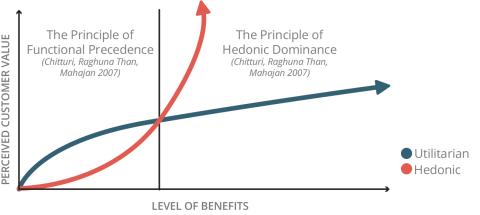Story by Margie Peterson
Ravi Chitturi found the principle that motivates us to pay more for beauty than functionality.
Why is it that people will buy a $20,000 Rolex watch even though they could buy a digital Timex for a tiny fraction of the price that tells time more accurately?
Consumers are programmed to make tradeoffs in product choices that fulfill the goals of minimizing negative emotions and maximizing positive emotions from the consumption of the purchased product. All products are a mix of utilitarian and hedonic attributes meant to minimize pain and maximize pleasure
respectively from the consumption
of those products.
In previous research, Ravi Chitturi, associate professor of marketing at Lehigh College of Business, found that positive emotions resulting from the consumption of increasing hedonic attributes increase the perceived customer value and willingness to pay much more than a proportionally comparable increase in utilitarian attributes for the products. (See chart.)
In the case of a Rolex, it’s because the aesthetically pleasing Rolex evokes self-expressive pride in customers while offering a functioning timepiece, albeit less accurate than a digital Timex, according to Chitturi.
A computer engineer, Chitturi, who was a product designer for Intel and IBM before joining the College of Business, says he was curious as to why Apple can charge about 35 percent more than the competition for their phones, laptops and other products. He started researching the question by surveying his students about their cell phone choices. About 95 percent had Apple iPhones.
“I asked, ‘Would you switch to an Android phone?’” Chitturi recalls. “They said, ‘Absolutely not.’”
He showed his students comparisons between Samsung phones and iPhones in which Samsung fared better in storage, display and microprocessor power and then he asked again if they would switch.
“They said, ‘Well, you know, it’s cool to own an iPhone. All my friends think it’s cool.’”
Chitturi’s research participants were asked to rate Apple and Samsung phones on three aspects: function, aesthetics and self-expressive pride. Owners of Apple and Samsung phones had similar levels of confidence in function, with Apple owners indicating slightly lower functional confidence.
But when it came to pride in ownership, Apple trounced Samsung.
“Apple had much higher self-expressive pride,” Chitturi reports. “Those people paying more for their iPhones reported much greater pride driven by visual aesthetics.”
Chitturi’s research focused on product aesthetics, not comparing brands. Next he went to a fine jewelry store and got information and pictures of 10 types of Seiko watches with various prices. He showed students photos of all 10 watches and asked them to rank each in terms of how visually attractive they were, giving the students no idea of the prices of each.
“Then I compared the rank order in price and rank order in visual aesthetics by these 200 students. There was about 90 percent correlation,” he says. “The best looking one was the highest priced.”
Broader studies with other participants reinforced those findings. The results held true in multiple experiments with different consumer goods. The studies bolstered Chitturi’s earlier research on visual aesthetics improving preference for sustainable products.
“Aesthetics evoke emotions of excitement and pride that facilitate higher profit margins,” he says. “People don’t buy products, people buy emotions and consume emotions.”
Marketers who understand that can make the case to their companies about the importance of designing products that are aesthetically pleasing.
“You will never buy anything that does not fulfill your emotional needs, real or perceived,” Chitturi says.
“That’s where marketing comes in.”
Why it Matters
To increase profit margins, companies should put more emphasis on leveraging the Principle of Hedonic Dominance without violating the principle of Functional Precedence.


